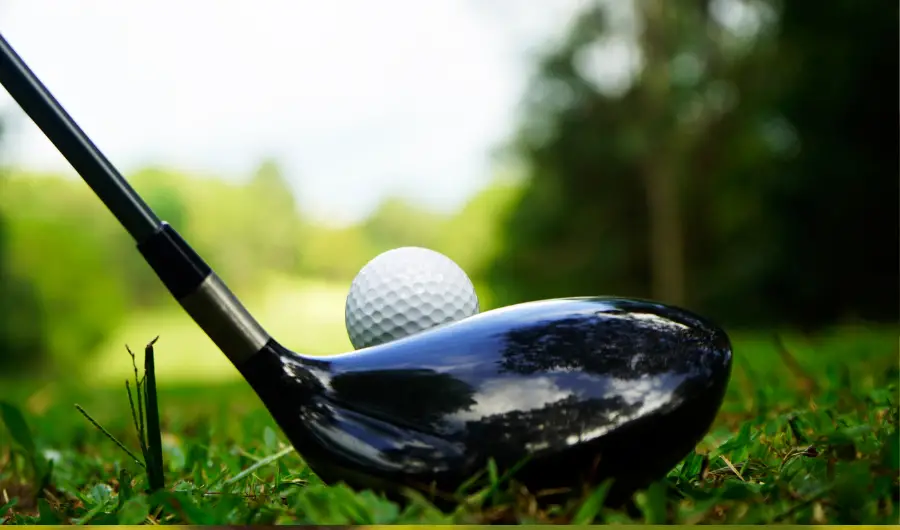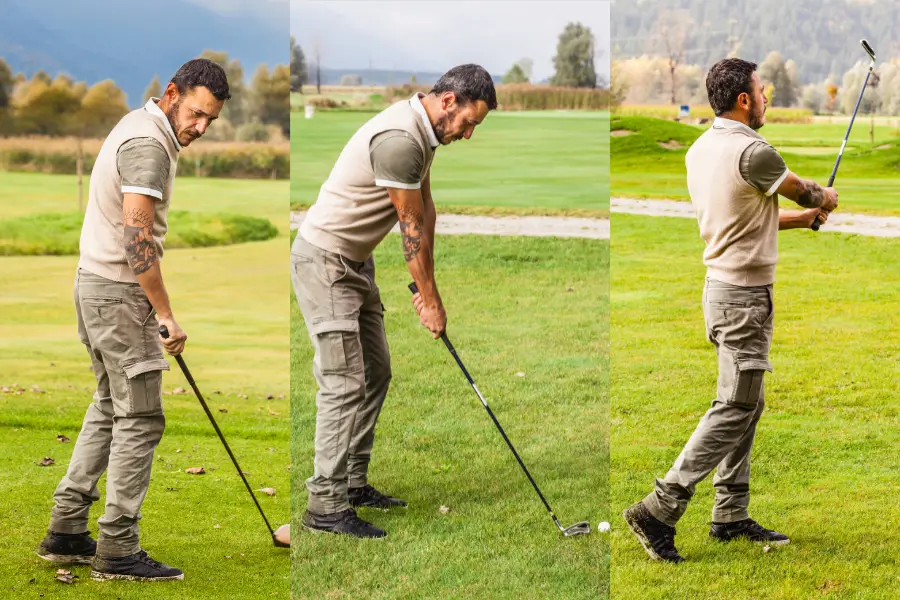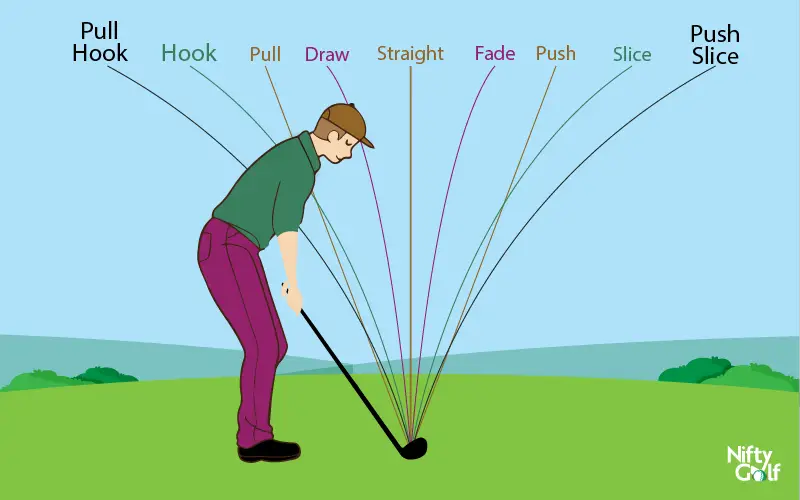If you’ve ever stood on the tee thinking whether to shape your shot with a draw or a fade, you’re not alone. Understanding the differences between these two shots and knowing when to utilize them can significantly impact your game.
Whether you’re an experienced golfer wanting to polish your shot-making skills, or a beginner trying to figure out the intricacies of it, this guide is in your interest.
In this guide, I will simplify the draw and fade shots for you through years of trial, error, and learning. We will discuss the techniques, challenges, and strategic considerations behind these two fascinating shots. So sit back, and let’s get into it.
Fade Vs Draw at a glance

Now, we are going to get into the most heated debate of golf, the Fade Vs the Draw – two golf shots that have been giving golfers sleepless nights since the beginning.
On one side, we have the Fade, going from left to right (for right-handed golfers) with a slightly open clubface at impact. It’s the go-to shot for difficult situations, allowing you to navigate around hazards with ease. Also, it has a higher trajectory.
On the other side, we have the Draw, moving from right to left (for right-handed golfers) with a slightly closed clubface at impact. It’s the choice for taking on dogleg holes. Also, its penetrating trajectory slices wind easily, adding an extra roll.
A deeper delve down: Draw vs Fade in golf
For further understanding, let’s go deeper into this discussion and explore the unique techniques that distinguish these two shots.
Both these shots have their advantages and add expertise to your game. However, the key difference lies in the clubface position at impact: a Fade has a slightly open clubface relative to the target line, while a Draw has a slightly closed clubface.
To execute a Fade, align your body and feet slightly left of the target (for right-handed golfers), open the clubface at the address, and maintain an outside-to-inside swing path. This controlled motion a left-to-right spin, allowing the ball to reach the green.
Conversely, to achieve a Draw, position your body and feet slightly right of the target (for right-handed golfers), close the clubface at address, and swing from inside to outside. This makes the right-to-left spin, adding power and roll for increased distance.

While both shots are valuable, the Fade can be more forgiving for many golfers. Its less aggressive swing path and trajectory often result in a more consistent ball flight, making it a go-to shot for precision and control. On the other hand, the Draw requires precise timing, making it a bit more challenging to execute.
The Challenges
You might have noticed that not even your top-notch players have the same preference when it comes to Draw vs Fade. That’s because both these shots present challenges that may seem minor to some but are crucial to others.
While the Fade is known for its precision, it can be challenging to control consistently. A minor imbalance at the open clubface can overdo it and turn it into a slice. Achieving the ideal trajectory with a Fade can also be tricky. Too high, and the ball may struggle to carry the distance needed; too low, and it could fall short of the target.
If you have a naturally outside-to-inside swing path, a draw can be difficult for you. Swinging from inside to outside consistently requires practice and adjustment. Overdraws can be a concern, resulting in shots that start too far to the right and end up far off target. Draws require a well-timed release, and if the timing is off, it can lead to hooks.
Mastering the art of shot selection: When to play Draw & when to play Fade
After exploring the challenges presented by both the Fade and the Draw, understanding when to play each shot becomes essential. For beginners, it’s essential to develop a strategy for choosing between these two shot shapes.
When to Hit a Fade
- When the hole presents a dogleg from left to right, a Fade can go around the bend, landing the ball on the green.
- With the pin position right, a fade, going from left to right is the way to go.
- When your ball ends up in the rough with a clear path to the green, opting for a Fade with an open clubface can help counter the rough’s resistance.

When to Hit a Draw:
- When faced with a dogleg left on par 4 or 5, a Draw is your best option. The right-to-left curvature enables you to shape your shot around the bend and gain a better angle for your approach shot.
- With the pin positioned on the left side of the green, a well-placed Draw shot can bring you closer to the pin.
The easiest way to practice
Practicing the Draw and Fade shots requires attention to key elements such as stance, equipment, and swing path. With all three of these under control, there is no stopping from hitting the perfect Fades and Draws every time. Here’s a simplified guide to help you get started:
Stance:
For a Fade (for right-handed golfers), align your feet, hips, and shoulders slightly left of the target. The ball should be placed slightly forward in your stance.

For a Draw (for right-handed golfers), align your feet, hips, and shoulders slightly right of the target. Place the ball slightly back in your stance.
Equipment:
Choose the appropriate club for the shot shape you want to practice. For the Fade, consider using a club with more loft, like a 7-iron or higher, as it will help promote a higher trajectory. For the Draw, a club with less loft, such as a 5-iron or lower, can help achieve a more penetrating ball flight.
Swing Path:

For the Fade, focus on an outside-to-inside swing path. This means your club should approach the ball from slightly outside the target line at impact, creating the left-to-right spin.
For the Draw, concentrate on an inside-to-outside swing path. Your club should approach the ball from slightly inside the target line at impact, generating the right-to-left spin.
🏌️♂️ Beginner Friendly Guide: How to get better at golf
Draw vs Fade vs Slice vs Hook (a quicker look)
Let’s take a quick look at the Draw, Fade, Slice, and Hook in golf to clear up any misconceptions and understand each shot shape better.
The Draw starts right of the target and curves back towards the center. Golfers achieve the Draw by swinging from inside to outside, with a slightly closed clubface at impact.
The Fade starts left of the target and curves back towards the center. To play a Fade, golfers use an outside-to-inside swing path with a slightly open clubface at impact.
The Slice is an unintended shot that curves dramatically from left to right (for right-handed golfers) and goes way off the target line.
The Hook is also an unintended shot that curves dramatically from right to left (for right-handed golfers) and goes well off the target line.
My take for novice golfers
As you continue your golf journey, keep in mind that there is no one-size-fits-all approach, and each golfer’s swing techniques and strengths determine which shot shape suits them best. Mastering the Draw and Fade in golf is a journey that requires practice and dedication.

Understanding the differences between these shots helps you figure out when to play which shot. Overcome the challenges by applying the techniques discussed above and keep practicing. Enjoy the journey, and let your club shine on the course.
🏌️♂️ Related Reads
- Are Golf Simulators accurate?
- What is an Approach Wedge?
- Handicap for a beginner
- What is Condor in golf?
- Best golf cart brands of the year
FAQs
Q) What is a draw or fade in golf?
A) In golf, a “draw” is a shot that curves from the golfer’s dominant hand to the opposite direction, while a “fade” curves from the golfer’s dominant hand to the other side. Draws go left for right-handed golfers and right for left-handed golfers, and fades go right for right-handed golfers and left for left-handed golfers.
Q) Is it better to play a draw or fade?
A) For most golfers, a fade is easier to play than a draw, especially with longer clubs like the driver. A fade can provide a higher carry distance, and it’s more forgiving, reducing the chances of severe hooks or slices. However, individual swing preferences play a role, and mastering both shots can be beneficial on the course.
Q) Why are drawers better than fades?
A) Draws are often favored in golf because they penetrate the wind better and can travel farther due to their lower spin.
Q) Why can’t I hit a fade?
A) Having trouble hitting a fade might be attributed to one of these factors: a too-closed stance, shoulders that are too closed, or a clubface that’s too closed at impact. These aspects can lead to an in-to-out swing path, making it difficult to achieve the desired fade shot shape. Correcting these elements in your swing can help you develop a fade.
Q) How do you hit a fade consistently?
A) To consistently hit a fade in golf:
- Use a slightly weaker grip.
- Align your body and feet slightly left of the target (for right-handed golfers).
- Position the ball slightly forward in your stance.
- Swing from outside to inside the target line.
- Keep the clubface slightly open at impact but square to the swing path.
Q) Is a draw longer than a fade?
A) Yes, a draw shot in golf is generally longer than a fade. The lower spin of a draw allows the ball to roll out more, providing additional distance in the air and on the ground.
Q) Can you hit a fade as far as a draw?
A) Yes, skilled golfers can hit a fade as far as a draw by making necessary swing adjustments. Both shot shapes have the potential for comparable distance with proper technique.
Q) How do you hit a fade and not a slice?
A) To hit a fade in golf, make sure the clubface is only open to the swing path, not the target line. If it’s open to both, it can lead to a weak shot that curves away (slice). A properly executed fade starts left of the target and gently curves back to the right.
Q) What alignment do you need to hit a draw?
A) To hit a draw in golf, align your body and feet slightly to the right of the target (for right-handed golfers). This encourages an in-to-out swing path, which is crucial for producing a draw shot shape.
Q) How do you position your feet to hit a draw?
A) To play a draw in golf, apply pressure on the inside of your right foot and the toe of your left foot during the swing. This generates an inside-out swing path, which produces the desired draw shot shape.
Q) How do you open the club face to hit a draw?
A) To hit a perfect draw, your clubface should be open to the target line but closed to your swing path at impact. This starts the ball right of the target and makes it curve back to finish on target.
Q) Do you hit a draw with a strong or weak grip?
A) A stronger grip, with the hands rotated slightly to the right (for right-handed golfers), can promote a slight draw ball flight. It also helps create an inside-to-out swing path, which is ideal for hitting a draw.
Q) Do you have to aim right to hit a draw?
A) To hit a draw in golf, you need to aim slightly right off the target. This is because a draw shot starts to the right of the target and then curves back to the left, finishing on target. By aligning to the right, you encourage an inside-to-out swing path, which is essential for producing a draw ball flight.
Q) What grip do you use to hit a draw with a driver?
A) To hit a draw with a driver, you can use a grip that is slightly stronger than your neutral grip. A stronger grip means rotating your hands slightly to the right (for right-handed golfers) on the club. This grip adjustment can help promote an inside-to-out swing path, which is essential for producing a draw shot shape. You can also check out this detailed guide about the best grip for beginners (written by Bryan Wood).
Q) Does Tiger Woods hit a draw or fade?
A) Tiger Woods’s preferred shot shape is a slight draw. However, he is skilled at shaping the ball both ways and has used fades and draws strategically throughout his career. As for amateur golfers, considering shot selection based on the hole layout, pin position, and potential hazards before starting their pre-shot routine is essential.
Jabez is the guy who started this blog with Bryan. He’s been playing golf since a young age and has a lot of experience to share. But more importantly, Jabez is someone who is always looking to help others out. He’s got a great sense of humor and is always up for a good laugh. But most importantly, Jabez is someone who cares about his followers and always wants to help them improve their game. For any queries reach out to him at Jabez@iamlearninghowtogolf.com.

